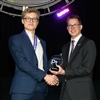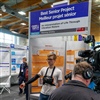Manning Whitby, a Danforth Collegiate and Technical Institute student in the Math and Science Technology (MaST) program, was one of just two participants to win a platinum award at the Canada-Wide Science Fair (CWSF) held recently in Fredericton, New Brunswick.
The event brought together some of the best and brightest young scientific minds from across the country to showcase innovative projects that seek to solve real-word issues. Whitby designed a wearable vest to assist those who are blind or visually impaired by providing greater spatial perception. The project, titled "Interpretation of Life Through Vibration Motors," also garnered a Ted Rogers Innovation award, Innovation Challenge award, Youth Can Innovate award, and a gold medal. By virtue of his success at the event, Whitby also scored an invitation to participate in the European Union Contest for Young Scientists (EUCYS), in Sofia Bulgaria later this year.
“The device works in two parts,” explained Whitby. “The collection system is a sensor unit worn over top of the user’s clothing and uses advanced ultrasonic and LIDAR technology to measure the environment and the obstacles within it. These measurements are communicated to the user as varying vibrations. This communication system is a form-fitting, unobtrusive second skin that is design to be worn underneath your clothing.” The aim of the device is ultimately to provide those with visual impairments the freedom to navigate with more independence, confidence, and comfort.
MaST@Danfort teacher Deryk Jackson said his student is a great young engineer whose success is due to dedication, hard work and community outreach over the past four years. “Manning's journey to platinum at the Canada Wide Science Fair started on his first day of school in Grade 9 when he began working on his science fair project five months early!”
The now-Grade 12 student said that he has always been interested in the concept of wearable technology and assistive devices, and the notion for the project actually first came to him even before that first year in high school. Over time, the idea was repeatedly tested, analyzed, and refined.
“His attention to detail is what makes him so successful in the world of science and at school,” said Danforth C&TI Principal Rob MacKinnon. “We’re all really proud of Manning and the MaST program and teachers that supported him on his journey to this impressive accomplishment. We’re excited to see where he takes the project next!” Whitby hopes to be able to make the solution more widely available, even as he moves on to post-secondary education opportunities.
“This year has been a milestone,” noted Whitby. “I focused on moving away from simply conceptualizing the design of the device, and making a mediocre model from these ideas, like I had in previous years, to really focus on applying scientific principles and process to design a device that was as effective in controlled environments and it was theorized. I focused deeply on collecting a lot of data from my work and practices and working directly with the blind and low vision community.” In so doing, he sought out partnerships with institutions such as the Canadian Council for the Blind, Canadian National Institute for Blind, and Ontario Blind Sports.
The coup de grace for the year is the national recognition at the CWSF where Whitby competed against some 500 like-minded students in an inspiring exploration of Science, Technology, Engineering, and Mathematics (STEM).
Whitby was not the only TDSB star to shine. A number of TDSB students qualified by virtue of success at regional competitions, and some left with prominent awards. Abby Mattina of Bloor CI secured a silver for her work, "Time to Switch to Switchgrass Bedding?" Ethan Breit of Western Technical and Commercial School took home a bronze medal for his project, "Performant GPU Path Tracing."

